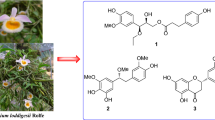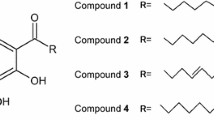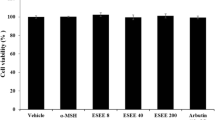Abstract
Antioxidant properties of eight Paeonia suffruticosa (Ps) extracts (Ps-1 to Ps-8) were evaluated. The respective half maximally effective concentration (EC50) values of Ps-1 ~ 8 were 10.0, 9.8, 63.6, >100, 3.8, 85.1, 6.9, and 0.7 μg/ml for 1,1-diphenyl-2-picrylhydrazyl radical (DPPH·) radical scavenging efficiency and 22.9, 11.4, 53.1, >100, 7.5, 97.6, 43.7, 4.2 μg/ml for 2,2′-azinobis(3-ethylbenzothiazoline-6-sulfonic acid) diammonium salt (ABTS·+) radical scavenging capacity. The Ps-8 exhibited high free radical scavenging capacity, ion-chelating ability, reducing power, and inhibition of lipid peroxidation, which may have been attributable to its abundant phenolic and flavonoid content. In Hs68 and B16 cells treated with 100 μg/ml Ps-1, Ps-3, Ps-4 and Ps-6, expressions of toxic activities were lower than those in cells treated with arbutin and ascorbic acid. The antimelanogenesis properties were also tested in B16 cells. Extract Ps-1, and particularly extract Ps-6, considerably inhibited cellular tyrosinase and 3,4-dihydroxyphenylalanine (DOPA) oxidase activity and also reduced melanin content in B16 cells by down-expression of melanocortin-1 receptor (MC1R), microphthalmia-associated transcription factor (MITF), tyrosinase, and tyrosinase-related proteins-1 (TRP-1). The results suggest that P. suffruticosa extracts have antioxidant and antimelanogenesis activities with potential applications in cosmetic materials or food additives.


Similar content being viewed by others
Abbreviations
- α-MSH:
-
α-melanocyte-stimulating hormone
- DMSO:
-
Dimethyl sulfoxide
- EC50 :
-
The half maximally effective concentration
- MC1R:
-
Melanocortin-1 receptor
- MITF:
-
Microphthalmia-associated transcription factor
- Ps:
-
Paeonia suffruticosa
- TBARS:
-
Thiobarbituric acid reactive substances
- TEAC:
-
Trolox equivalent antioxidant capacity
- TRP-1:
-
Tyrosinase-related proteins-1
References
Lin HC, Ding HY, Wu YC (1998) Two novel compounds from Paeonia suffruticosa. J Nat Prod 61:343–346
Zhou H, Wong YF, Cai X, Liu ZQ, Jiang ZH, Bian ZX, Xu HX, Liu L (2006) Suppressive effects of JCICM-6, the extract of an anti-arthritic herbal formula, on the experimental inflammatory and nociceptive models in rodents. Biol Pharm Bull 29:253–260
Wu M, Gu Z (2009) Screening of bioactive compounds from moutan cortex and their anti-inflammatory activities in rat synoviocytes. Evid Based Complement Alternat Med 6:57–63
Zhong SZ, Ge QH, Qu R, Li Q, Ma SP (2009) Paeonol attenuates neurotoxicity and ameliorates cognitive impairment induced by d-galactose in ICR mice. J Neurol Sci 15:58–64
Oh GS, Pae HO, Choi BM, Lee HS, Kim IK, Yun YG, Kim JD, Chung HT (2004) Penta-O-galloyl-beta-D-glucose inhibits phorbol myristate acetate-induced interleukin-8 [correction of intereukin-8] gene expression in human monocytic U937 cells through its inactivation of nuclear factor-kappaB. Int Immunopharmacol 4:377–386
Villareal MO, Han J, Yamada P, Shigemori H, Isoda H (2010) Hirseins inhibit melanogenesis by regulating the gene expressions of Mitf and melanogenesis enzymes. Exp Dermatol 19:450–457
Liang CH, Chou TH, Ding HY (2010) Inhibition of melanogensis by a novel origanoside from Origanum vulgare. J Dermatol Sci 57:170–177
Wang HM, Chen CY, Chen CY, Ho ML, Chou YT, Chang HC, Lee CH, Wang CZ, Chu IM (2010) (-)-N-Formylanonaine from Michelia alba as a human tyrosinase inhibitor and antioxidant. Bioorg Med Chem 18:5241–5247
Kim YJ (2007) Antimelanogenic and antioxidant properties of gallic acid. Biol Pharm Bull 30:1052–1055
Re R, Pellegrini N, Proteggente A, Pannala A, Yang M, Rice-Evans C (1999) Antioxidant activity applying an improved ABTS radical cation decolorization assay. Free Radic Biol Med 26:1231–1237
Hamad I, Erol-Dayi O, Pekmez M, Onay-Uçar E, Arda N (2010) Antioxidant and cytotoxic activities of Aphanes arvensis extracts. Plant Foods Hum Nutr 65:44–49
Parejo I, Viladomat F, Bastida J, Rosas-Romero A, Flerlage N, Burillo J, Codina C (2002) Comparison between the radical scavenging activity and antioxidant activity of six distilled and nondistilled mediterranean herbs and aromatic plants. J Agric Food Chem 50:6882–6890
Jia Z, Tang M, Wu J (1999) The determination of flavonoids content in mulberry and scavenging effect on superoxide radicals. Food Chem 64:555–599
Decker EA, Welch B (1990) Role of ferritin as a lipid oxidation catalyst in muscle food. J Agric Food Chem 38:674–677
Barreira JC, Ferreira IC, Oliveira MB, Pereira JA (2008) Antioxidant activity and bioactive compounds of ten Portuguese regional and commercial almond cultivars. Food Chem Toxicol 46:2230–2235
Mimica-Dukic N, Bozin B, Sokovic M, Simin N (2004) Antimicrobial and antioxidant activities of Melissa officinalis L. (Lamiaceae) essential oil. J Agric Food Chem 52:2485–2489
An SM, Lee SI, Choi SW, Moon SW, Boo YC (2008) p-Coumaric acid, a constituent of Sasa quelpaertensis Nakai, inhibits cellular melanogenesis stimulated by alpha-melanocyte stimulating hormone. Br J Dermatol 159:292–299
Winder AJ (1994) A stopped spectrophotometric assay for the dopa oxidase activity of tyrosinase. J Biochem Biophys Methods 28:173–183
Jee SH, Lee SY, Chiu HC, Chang CC, Chen TJ (1994) Effects of estrogen and estrogen receptor in normal human melanocytes. Biochem Biophys Res Commun 199:1407–1412
Huang D, Ou B, Prior RL (2005) The chemistry behind antioxidant capacity assays. J Agric Food Chem 53:1841–1856
Zhao H, Dong J, Lu J, Chen J, Li Y, Shan L, Lin Y, Fan W, Gu G (2006) Effects of extraction solvent mixtures on antioxidant activity evaluation and their extraction capacity and selectivity for free phenolic compounds in barley (Hordeum vulgare L.). J Agric Food Chem 54:7277–7286
Jochmann N, Baumann G, Stangl V (2008) Green tea and cardiovascular disease: From molecular targets towards human health. Curr Opin Clin Nutr Metab Care 11:758–765
Stashenko EE, Puertas MA, Martínez JR (2002) SPME determination of volatile aldehydes for evaluation of in-vitro antioxidant activity. Anal Bioanal Chem 373:70–74
Liu JY, Chen CC, Wang WH, Hsu JD, Yang MY, Wang CJ (2006) The protective effects of Hibiscus sabdariffa extract on CCl4-induced liver fibrosis in rats. Food Chem Toxicol 44:336–343
Sreelatha S, Padma PR (2009) Antioxidant activity and total phenolic content of Moringa oleifera leaves in two stages of maturity. Plant Foods Hum Nutr 64:303–311
Ding HY, Lin HC, Chang TS (2009) Tyrosinase inhibitors isolated from the roots of Paeonia suffruticosa. J Cosmet Sci 60:347–352
Ryu G, Park EK, Joo JH, Lee BH, Choi BW, Jung DS, Lee NH (2001) A new antioxidant monoterpene glycoside, alpha-benzoyloxypaeoniflorin from Paeonia suffruticosa. Arch Pharm Res 24:105–108
Westenburg HE, Lee KJ, Lee SK, Fong HH, van Breemen RB, Pezzuto JM, Kinghorn AD (2000) Activity-guided isolation of antioxidative constituents of Cotinus coggygria. J Nat Prod 63:1696–1698
Author information
Authors and Affiliations
Corresponding author
Electronic Supplementary Material
Below is the link to the electronic supplementary material.
Suppl. 1
Partition and fraction processes of P. suffruticosa. (DOC 30 kb)
Suppl. 2
HPLC chromatogram fingerprint pattern of Ps-6 and Ps-8 of P. suffruticosa. (a) Ps-6: peak 3, mudanpioside E; peak 10, mudanpioside B, and peak 15, suffrutioside E. (b) Ps-8: peak 1, tetragalloyl glucode; peak 2, pentagalloyl glucose; peak 3, galloylpaeoniflorin; peak 6, mudanpioside C; peak 7, benzyoylpaeoniflorin, and peak 9, mudanpioside B. (DOC 80 kb)
Rights and permissions
About this article
Cite this article
Ding, HY., Chou, TH., Lin, RJ. et al. Antioxidant and Antimelanogenic Behaviors of Paeonia suffruticosa . Plant Foods Hum Nutr 66, 275–284 (2011). https://doi.org/10.1007/s11130-011-0235-3
Published:
Issue Date:
DOI: https://doi.org/10.1007/s11130-011-0235-3




